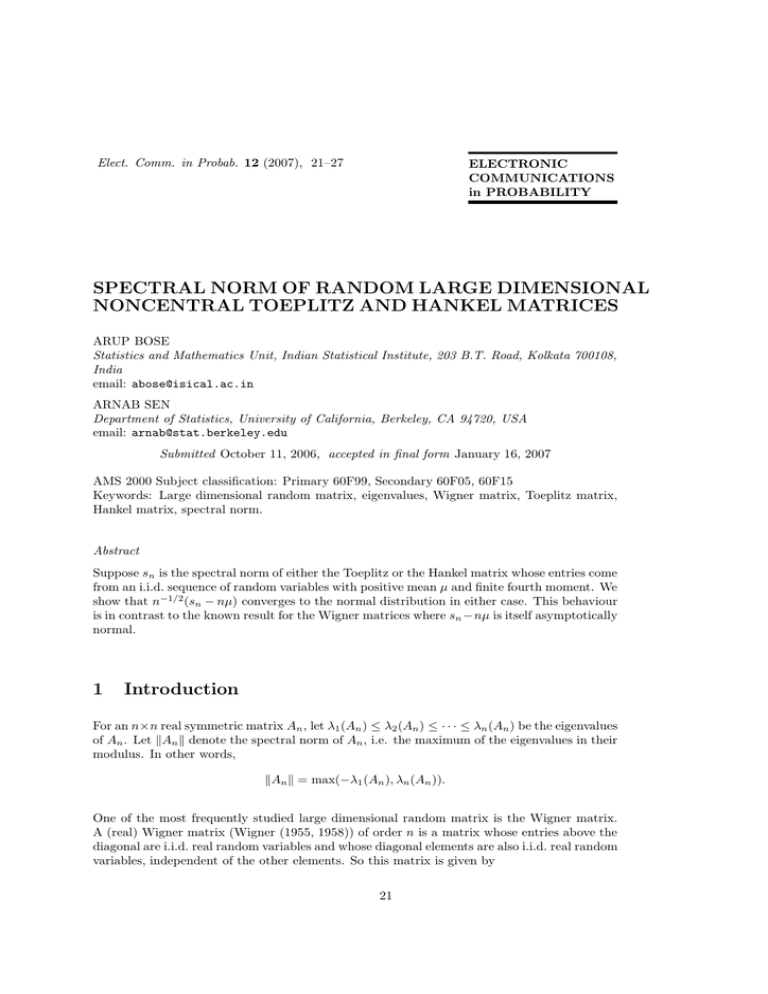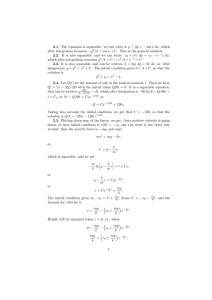SPECTRAL NORM OF RANDOM LARGE DIMENSIONAL NONCENTRAL TOEPLITZ AND HANKEL MATRICES
advertisement

Elect. Comm. in Probab. 12 (2007), 21–27
ELECTRONIC
COMMUNICATIONS
in PROBABILITY
SPECTRAL NORM OF RANDOM LARGE DIMENSIONAL
NONCENTRAL TOEPLITZ AND HANKEL MATRICES
ARUP BOSE
Statistics and Mathematics Unit, Indian Statistical Institute, 203 B.T. Road, Kolkata 700108,
India
email: abose@isical.ac.in
ARNAB SEN
Department of Statistics, University of California, Berkeley, CA 94720, USA
email: arnab@stat.berkeley.edu
Submitted October 11, 2006, accepted in final form January 16, 2007
AMS 2000 Subject classification: Primary 60F99, Secondary 60F05, 60F15
Keywords: Large dimensional random matrix, eigenvalues, Wigner matrix, Toeplitz matrix,
Hankel matrix, spectral norm.
Abstract
Suppose sn is the spectral norm of either the Toeplitz or the Hankel matrix whose entries come
from an i.i.d. sequence of random variables with positive mean µ and finite fourth moment. We
show that n−1/2 (sn − nµ) converges to the normal distribution in either case. This behaviour
is in contrast to the known result for the Wigner matrices where sn −nµ is itself asymptotically
normal.
1
Introduction
For an n×n real symmetric matrix An , let λ1 (An ) ≤ λ2 (An ) ≤ · · · ≤ λn (An ) be the eigenvalues
of An . Let kAn k denote the spectral norm of An , i.e. the maximum of the eigenvalues in their
modulus. In other words,
kAn k = max(−λ1 (An ), λn (An )).
One of the most frequently studied large dimensional random matrix is the Wigner matrix.
A (real) Wigner matrix (Wigner (1955, 1958)) of order n is a matrix whose entries above the
diagonal are i.i.d. real random variables and whose diagonal elements are also i.i.d. real random
variables, independent of the other elements. So this matrix is given by
21
22
Electronic Communications in Probability
Wn =
w11
w21
..
.
w12
w22
..
.
w13
w23
..
.
...
...
..
.
w1(n−1)
w2(n−1)
..
.
w1n
w2n
..
.
wn1
wn2
wn3
. . . wn(n−1)
wnn
(1)
where wkj = wjk j < k, are i.i.d. (real) random variables and the diagonal elements wii are
i.i.d. real random variables and are independent of the off diagonal variables.
There are a host of results known for the Wigner matrix and its variants. We quote below the
results relevant to us on their spectral norm and extreme eigenvalues.
2
Theorem 1. Suppose {Wn } is a sequence of Wigner matrices of order n such that E(w11
)=1
4
and E(w11 ) < ∞.
1
(A) If E(w11 ) = 0, then the maximum eigenvalue of n− 2 Wn converges to 2 almost surely.
(B) Assume that the mean µ of the entries is positive. Let ϕn be the spectral norm of Wn .
d
Then ϕn − µn → N (0, 1).
Part A is proved in Bai and Yin (1988). Part B is due to Silverstein (1994).
Observe that in Part B, the mean of the entries is assumed to be positive. We call this the
noncentral case. It is interesting to note that for the distributional convergence, only centering
suffices and no scaling is required.
Nonrandom Toeplitz and Hankel matrices are extremely well studied in mathematics, specially
in operator theory. Let {x0 , x1 , . . .} be a sequence of real numbers.
Then the n × n Toeplitz Matrix is the matrix whose (i, j)-th entry is x|i−j| . So it is given by
Tn
=
x0
x1
x2
..
.
x1
x0
x1
..
.
x2
x1
x0
..
.
xn−1
xn−2
xn−3
. . . xn−2
. . . xn−3
. . . xn−4
..
..
.
.
...
x1
xn−1
xn−2
xn−3
..
.
x0
.
Hankel matrices have very close connections with the Toeplitz matrices. The n × n Hankel
Matrix is the matrix whose (i, j)-th entry is xi+j−2 . So it is given by
Hn
=
x0
x1
x2
..
.
x1
x2
x3
..
.
x2
x3
x4
..
.
xn−1
xn
xn+1
...
...
...
..
.
xn−2
xn−1
xn
..
.
xn−1
xn
xn+1
..
.
. . . x2n−3
x2n−2
.
The question of existence of limiting spectral distribution for the eigenvalues of random Toeplitz
and Hankel matrices has been settled recently. See Bryc et. al (2006).
Spectral norm of noncentral Toeplitz and Hankel
23
Theorem 2 (Bryc, Dembo and Jiang (2006)). Let the {xi } in the Toeplitz (Hankel) matrix
Tn (Hn ) be i.i.d. with mean zero and variance one. Then with probability one, the empirical
spectral distribution of √1n Tn ( √1n Hn ) converges weakly as n → ∞ to a nonrandom symmetric
probability measure which does not depend on the distribution of the entries {xi } and has
unbounded support.
Also see Hammond and Miller (2005) for some detailed information on the behavior of empirical
spectral moments of random Toeplitz matrices. Unlike the Wigner case, apparently, there are
no results known for the behavior at the edge of the spectrum of the random Toeplitz and the
Hankel matrices. In the next section we consider Toeplitz and Hankel matrices where {xi } are
i.i.d. with mean µ > 0. We show that the spectral norm of both the Toeplitz and the Hankel
matrices obey a strong law and also converges to a normal distribution under appropriate
centering and scaling.
2
Main results and proofs
Suppose {xi } are i.i.d. and have mean µ. Let Tn be the Toeplitz matrix formed by these {xi }.
Let un = n−1/2 (1, 1, · · · , 1)T . Then Tn◦ = Tn − µnun uTn is the corresponding centered Toeplitz
| {z }
ntimes
matrix whose entries have mean zero. We now state our main theorem.
Theorem 3. Suppose Tn is a Toeplitz matrix where E(x0 ) = µ > 0 and Var(x0 ) = 1. Let
Tn◦ = Tn − µnun uTn . Then,
(A)
kTn k
→µ
n
almost surely and k
Tn◦
k→0
kTn k
almost surely.
(B) Further assume E(x40 ) < ∞. Then for Mn = kTn k or Mn = λn (Tn ),
Mn − µn
√
→ N (0, 4/3)
n
in distribution.
(C) If Tn and Tn◦ are replaced by the corresponding Hankel matrices, then (A) holds. Further,
(B) holds with the limiting variance being changed from 4/3 to 2/3.
Before going to the proof of the theorem let us state the following Lemma.
Lemma 1. Let Tn and Tn◦ be as above. Then
(i) If E(x20 ) < ∞, then n−1 kTn◦ k → 0 a.s.
(ii) If E(x40 ) < ∞, then n−3/4 kTn◦ k is tight.
Proof Let yi = xi − µ. Define yic = yi I(|yi | ≤ c) − E yi I(|yi | ≤ c) , the truncated and centered
(c)
version of yi . Let Tn be the Toeplitz matrix formed by the sequence {yic }.
1/2
(c) (c)
(c)
Then n−1 kTn◦ k − kTn k ≤ n−1 kTn◦ − Tn k ≤ n−2 Tr[(Tn◦ − Tn )2 ]
.
24
Electronic Communications in Probability
i = 0, 1, 2, · · · . Clearly, {ric }’s are i.i.d. and E (r0c )2 → 0 as c → ∞.
Pn−1
Pn−1
(c)
Now n−2 Tr[(Tn◦ − Tn )2 ] = n−2 [2 i=1 (n − i)(ric )2 + n(r0c )2 ] ≤ 2n−1 i=0 (ric )2 → E(r0c )2 as
(c)
n → ∞ by SLLN. So, we just need to show that n−1 kTn k → 0.
Define ric = yi − yic ,
To complete the proof of part (i), we extract a crucial fact from the proof of Theorem ??
given in Bryc, Dembo and Jiang (2006). If we carefully follow their argument, it is clear that
(c)
for bounded mean zero random variables, n−3 Tr[(Tn )4 ] converges to some positive constant
almost surely. Hence,
(n−1 kTn(c)k)4 ≤ n−4 Tr[(Tn(c) )4 ] → 0
almost surely.
To prove part (ii), it is enough to show the fourth moment is uniformly bounded. But this is
true since,
P
E (n−3/4 kTn◦ k)4 ≤ n−3 E[Tr (Tn◦ )4 ] = n−3 E( i1 ,i2 ,i3 ,i4 y|i1 −i2 | y|i2 −i3 | y|i3 −i4 | y|i4 −i1 | ) = O(1)
from Bryc, Dembo and Jiang (2006).
Thus the proof of the Lemma is complete.
Proof of Theorem ?? We will prove only Parts A and B. The proof of Part C is similar and
will be omitted.
Using the triangle inequality for norms,
kµnun uTn k − kTn◦ k ≤ kTn k ≤ kµnun uTn k + kTn◦k
or, µ − k
kTn k
T◦
Tn◦
k≤
≤ µ + k n k.
n
n
n
Thus using Lemma ??(i) , we easily conclude kTnn k →µ almost surely. This proves the first
part of (A). The second part now follows again from Lemma ??(i)
We now prove part (B). Define the three sets,
(n)
Ω1
= {k
Tn◦
k ≤ 1/2},
kTn k
(n)
Ω2
= {n−1 kTn◦ k < µ/2},
(n)
(n)
Ω(n) = Ω1 ∩ Ω2 .
For simplicity we will drop the superscript and write Ω1 , Ω2 and Ω for the above three sets
respectively. Note that from Lemma ??(i) and first part of the Theorem, given ǫ > 0, for all
large n,
P (Ω) > 1 − ǫ.
P∞
Suppose A is any matrix such that kAk < α < 1. Then (I−A)−1 = j=0 Aj and k(I−A)−1 k <
(1 − α)−1 .
Hence, on the set Ω1 , (I −
1
◦ −1
kTn k Tn )
exists and
||(I −
1
T ◦ )|| ≤ 2.
kTn k n
(2)
The following fact is well known in the theory of matrices (See Horn and Johnson (1985)
Corollary 6.3.4).
Spectral norm of noncentral Toeplitz and Hankel
25
Fact. Suppose λ̂ is an eigenvalue of A + P , where A is normal (that is AAT = AT A). Then
there exists an eigenvalue λ of A such that |λ̂ − λ| ≤ kP k.
Using this fact and noting that the distinct eigenvalues of µnun uTn are 0 and µn, we get
λ1 (Tn ) ≥ −kTn◦k.
and
λn (Tn ) ≥ µn − kTn◦k.
Hence on Ω2 (i.e. if n−1 kTn◦ k < µ/2), we have
λn (Tn ) > −λ1 (Tn ).
So, on Ω2
kTn k = λn (Tn ).
(3)
Then there exists an eigenvector g 6= 0 such that Tn g = λn (Tn )g or equivalently, (Tn◦ +
µnun uTn )g = λn (Tn )g. Noting that uTn g is just a real number, this implies that µnuTn gun =
λn (Tn )I − Tn◦ g.
Now we will work on the set Ω, on which
g = µnuTn g(λn (Tn )I − Tn◦ )−1 un .
Note that by the last relation, uTn g 6= 0 and hence premultiplying both sides of this relation
by uTn ,
λn (Tn ) = µnuTn (I −
1
T ◦ )−1 un .
λn (Tn ) n
Motivated by the above relation, define
λ̃n =
µn 1 +
0
1
T ◦
λn (Tn ) un Tn un
T◦
1
n
+ ( λn (T
)2 uTn (Tn◦ )2 un + uTn ( λn (T
)3 (I −
n)
n)
1
◦ −1
un
λn (Tn ) Tn )
on the set Ω
otherwise
(4)
We have λ̃n = λn (Tn ) on Ω1 . Also recall that on the set Ω2 , λn (Tn ) = kTn k and P (Ω) → 1.
So, λ̃n − λn (Tn ) = op (1) and λ̃n − kTn k = op (1). Hence, it is enough to find the limiting
distribution of λ̃n .
Consider the last three terms of λ̃n on Ω. Call them B2 , B3 and B4 .
B4 . Using inequality (??),
|B4 |
√
n
1
Tn◦ 3
) (I −
Tn◦ )−1 un λn (Tn )
λn (Tn )
kT ◦ k 3
n
≤ 2µn1/2
λn (Tn )
2µ n 3 kTn◦ k 3
=
→ 0 in probability by Lemma ??(ii)
n1/4 λn (Tn )
n3/4
= µn1/2 uTn (
26
Electronic Communications in Probability
Hence
B4
√
n
= op (1).
B3 .
n 2
µn
T
◦ 2
n−1 uTn (Tn◦ )2 un .
u
(T
)
u
=
µ
n
n
n
{z
}
(λn (Tn ))2
λn (Tn ) |
An say
We have
E(A2n )
= n−4 E
h X
i,j,k
= n
−4
E
X
y|i−j| y|j−k|
2 i
y|i1−j1| y|j1−k1| y|i2−j2| y|j2−k2| = O(1).
where yi = xi − µ is the centered version of {xi }. The last step above follows from argument
B3
similar to those given in Bryc, Dembo and Jiang (2006). So, {An } is tight. Hence √
→ 0.
n
B2 .
nµ
λn (Tn )
=
2
n
→ 1 and uTn Tn◦ un =
Pn−1
i=0
(n − i)yi +
ny0
n
1
n
P
y|i−j|
Pn−1
= n1 [2 i=0
(n − i)yi − ny0 ].
i,j
By central limit theorem for sums of independent random variables, it easily follows that
B2
√
→ N (0, 4/3) in distribution.
n
Combining the above steps, we have
λ̃n√
−µn
n
d
→ N (0, 4/3). This completes the proof of part
(B) since as we have already observed that on Ω, λ̃n = λn (Tn ) = kTn k and P (Ω) → 1.
Acknowledgement The authors are grateful to the Referee for his extremely prompt and
meticulous report. This manuscript has greatly benefited from his detailed comments.
References
[1] Bai, Zhidong and Yin, J. F. (1988). Necessary and sufficient condition for the almost
sure convergence of the largest eigenvalue of Wigner Matrices Ann. Probab., 16, No. 4,
1729–1741. MR0958213
[2] Bryc, Wlodzimierz, Dembo, Amir and Jiang, Tiefeng (2006). Spectral measure of large
random Hankel, Markov and Toeplitz matrices. Ann. Probab., 34, no. 1, 1–38. Also available at http://arxiv.org/abs/math.PR/0307330 MR2206341
[3] Hammnond, Christopher and Miller, Steven J. (2005). Distribution of eigenvalues for the
ensemble of real symmetric Toeplitz matrices. J. Theoret. Probab., 18, no. 3, 537–566.
MR2167641
[4] Horn, R. A. and Johnson C. R.(1985) Matrix Analysis Cambridge Univ. Press. MR0832183
[5] Silverstein, J. W. (1994). The Spectral Radii and norms of large dimensional non-central
random matrices Commun. Statist.-Stochastic Models, 10(3), 525–532. MR1284550
Spectral norm of noncentral Toeplitz and Hankel
[6] Wigner, E. P. (1955). Characteristic vectors of bordered matrices with infinite dimensions.
Ann. of Math., (2), 62, 548–564 MR0077805
[7] Wigner, E. P. (1958). On the distribution of the roots of certain symmetric matrices. Ann.
of Math., (2), 67, 325–327 MR0095527
27


